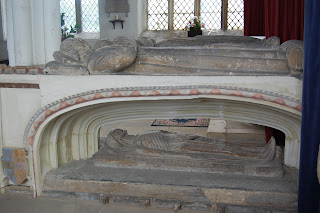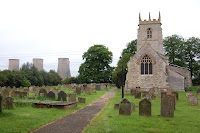Trent Valley Firsts
On a dull 1 June our aim was to reach the Saxon/Norman minster at Stow in Lindsey. To get there we travelled for the first time down the Trent Valley north of Newark and visited a largely unremarkable set of small tower churches. The contrast with the richly decorated churches of Rutland and South Lincolnshire was startling. No exuberant spires here. The first church we visited, however, was something of an exception.Holme is a curiousity, with little architectural coherence, a tile roof and a stumpy little spire. In many ways, though, it was, with Stow, the highlight of the trip. It has a scarcely- touched interior, medieval stained glass, Perpendicular windows, a double monument with a skeleton underneath, a room over the porch and some delightful bench carvings. It was a pleasure to have access to the key (and a bathroom) from friendly neighbours across the road and the signboard emphasised the welcome it gives to visitors.

 |
| Two-tiered monument to John Barton |
 |
| John Barton's shields on the porch |
 |
| Elegantly-hatted Isabella Barton |
 |
| Bench-end angels |
"Pray for the soul of John Barton, merchant of the Staple of Calais, d. 1491, who built this church."John Barton was a Lancashire man and Simon Jenkins, in his book "England's Thousand Best Churches", surmises that he set up in Holme when he was following his sheep to the east coast ports. In medieval times, Holme was on the western side of the Trent whereas now the river has shifted and has put the village on the eastern, Lincolnshire, side, although still inside the Nottinghamshire boundary.

For the first time we met some other church crawlers and we went round the interior with them. They were from Clacton in Essex and were knowledgable members of a U3A church visiting group . (Chris's photo).
 On this trip it was difficult to ignore how close we were to the River Trent. Slightly worrying evidence at Collingham recorded flood levels on the churchyard wall.
On this trip it was difficult to ignore how close we were to the River Trent. Slightly worrying evidence at Collingham recorded flood levels on the churchyard wall.Across the river from St George's, Clifton (North and South), High Marnham's power station towers were a looming presence and provided a bizarre resonance with the family name (Cooling) on two churchyard headstones.
 It was in Clifton that Chris discovered that his new bridge camera allowed him to take a shot of a stained glass window in the north aisle from outside a clear window in the opposite wall of the nave. That's a facilty we will no doubt be making more use of in this part of the East Midlands, as many churches are locked as a matter of course. Today, however, we benefited from the courtesy of key holders at Langford and Marton, in addition to Holme, so thanks to all of them.
It was in Clifton that Chris discovered that his new bridge camera allowed him to take a shot of a stained glass window in the north aisle from outside a clear window in the opposite wall of the nave. That's a facilty we will no doubt be making more use of in this part of the East Midlands, as many churches are locked as a matter of course. Today, however, we benefited from the courtesy of key holders at Langford and Marton, in addition to Holme, so thanks to all of them.But more of those churches another time. What we really wanted to see was Stow. Visiting our first "minster" on these trips, we were greeted by a peal of bells (some bell ringers from Suffolk were visiting too). It is a huge parish church ("monumental", Pevsner calls it), originating from 1034-1050, with later additions and a sympathetic Victorian re-build of the chancel roof and east wall by J.L. Pearson. Known as "the mother of Lincoln cathedral", which it pre-dates, from the outside it looks like a cathedral in its own right. It is a "four star" church among Simon Jenkins' top one thousand, putting it in his top 100.
Inside, the church has a decided "wow" factor. It is enormously high, with huge Saxon and later Gothic arches in the crossing, supporting the tower, which was replaced in the 15th Century. The "blind" canopied arcades around the chancel suggest that there were seats for a large number of priests, consistent with the function of a minster church in a system of church management before there were parishes. Stow was the base for pre-Norman bishops and was responsible for pastoral care and land management for a large area (explained in a free guide to the church).
There was so much to see that the photos below give only a taster. The font has pagan carvings all around it, supposedly symbolising the casting off of superstition at the sacrament of baptism. A Saxon doorway has been revealed underneath plaster and a brightly-coloured window high in the south wall gives St Hugh of Lincoln a proprietorial view of the whole magnificent church.
 |
| Crossing tower arches |
 |
| Green man on font |
 |
| Saxon doorway |
 |
| St Hugh window |
With much to absorb in these two feature churches, the remaining 10 or 11 we visited will be held over. In conclusion, however, another "first" cannot go unmentioned. That was the rare example in the tiny St Edith's church at Coates-by-Stow of a rood loft, the only one remaining in Lincolnshire. These were usually torn down during the Reformation so it is exceptional to see the wooden gallery, the faded paintings of the head of the Virgin and sprays of flowers on the tympanum and the rickety stone stairs in the wall which actually lead somewhere!


Click on any photo for an enlargement.



